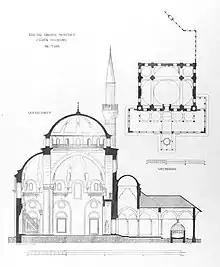Mihrimah Sultan Mosque, Üsküdar
The Mihrimah Sultan Mosque (İskele Mosque, Jetty Mosque, Turkish: Mihrimah Sultan Camii, İskele Camii) is a 16th century Ottoman mosque overlooking the waterfront in the historic center of the Üsküdar district of Istanbul, Turkey. One of Üsküdar's best-known landmarks, it takes its alternative name from the ferry terminal near which it stands. Before the coast road was built, the mosque would have stood right beside the water, accessible by boat.
| Mihrimah Sultan Mosque | |
|---|---|
 | |
| Religion | |
| Affiliation | Sunni Islam |
| Location | |
| Location | Istanbul, Turkey |
 Shown within Istanbul | |
| Geographic coordinates | 41°01′36″N 29°00′58″E |
| Architecture | |
| Architect(s) | Mimar Sinan |
| Type | Mosque |
| Groundbreaking | c. 1543-44 |
| Completed | 1548 |
| Specifications | |
| Dome height (outer) | 24.2 m (79 ft) |
| Dome dia. (outer) | 11.4 m (37 ft) |
| Minaret(s) | 2 |
| Materials | ashlar |

History
The mosque was designed by the imperial architect Mimar Sinan and built between 1543-44 and 1548.[1] It is the earlier of the two Friday mosques in Istanbul commissioned by Mihrimah Sultan, daughter of Sultan Suleiman the Magnificent and wife of Grand Vizier Rüstem Pasha.
Architecture
The large mosque stands on a raised platform with a broad double portico that contains a fine marble ablutions fountain. The architecture features several hallmarks of Mimar Sinan's mature style: a spacious, high-vaulted basement, slender minarets and a single-domed baldacchino flanked by three semi-domes ending in three exedrae.
The exterior is composed of ashlar, a thin dressed stone of gray to cream color. The interior walls and mimber are of Imported marble surrounds.[2]
One of the minarets still bears a carved sundial.
It was originally part of a complex, parts of which also survive although they now have different purposes.
_(19).jpg.webp)
_(31).jpg.webp)
_(12).jpg.webp)
_(32).jpg.webp)
Gallery
 Ablution fountain
Ablution fountain The frontal view
The frontal view Interior view of the dome
Interior view of the dome Mihrimah Sultan Mosque Uskudar from hill behind
Mihrimah Sultan Mosque Uskudar from hill behind Mihrimah Sultan Mosque Uskudar from the west
Mihrimah Sultan Mosque Uskudar from the west Mihrimah Sultan Mosque Uskudar son cemaat area
Mihrimah Sultan Mosque Uskudar son cemaat area Mihrimah Sultan Mosque Uskudar with ablutions fountain
Mihrimah Sultan Mosque Uskudar with ablutions fountain Mihrimah Sultan Mosque Uskudar son cemaat part
Mihrimah Sultan Mosque Uskudar son cemaat part Mihrimah Sultan Mosque Uskudar from graveyard
Mihrimah Sultan Mosque Uskudar from graveyard Mihrimah Sultan Mosque Uskudar dome
Mihrimah Sultan Mosque Uskudar dome Mihrimah Sultan Mosque Uskudar domes
Mihrimah Sultan Mosque Uskudar domes Mihrimah Sultan Mosque Uskudar minber and mihrab
Mihrimah Sultan Mosque Uskudar minber and mihrab Mihrimah Sultan Mosque Uskudar window
Mihrimah Sultan Mosque Uskudar window Endowment Deed of Mihrimah Sultan. This document concerns the endowment of properties in Anatolia and Rumelia, from which revenues were to be used to meet the expenses of the Mihrimah Sultan Mosque. April-March 1550. Sadberk Hanım Museum
Endowment Deed of Mihrimah Sultan. This document concerns the endowment of properties in Anatolia and Rumelia, from which revenues were to be used to meet the expenses of the Mihrimah Sultan Mosque. April-March 1550. Sadberk Hanım Museum

References
- Necipoğlu 2005, p. 301.
- Rogers, J. M. (1982). "The State and the Arts in Ottoman Turkey Part 1. The Stones of Suleymaniye". International Journal of Middle East Studies. 14 (1): 71–86. doi:10.1017/S0020743800026593. JSTOR 163335.
Sources
- Necipoğlu, Gülru (2005). The Age of Sinan: Architectural Culture in the Ottoman Empire. London: Reaktion Books. ISBN 978-1-86189-253-9.



.svg.png.webp)